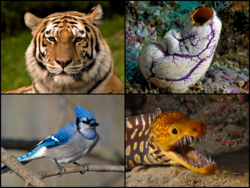| Olfactores | |
|---|---|
 | |
| Example of Olfactores | |
| Scientific classification | |
| Kingdom: | Animalia |
| Phylum: | Chordata |
| Clade: | Olfactores Jefferies, 1991 |
| Subphyla | |
Olfactores is a clade within the Chordata that comprises the Tunicata (Urochordata) and the Vertebrata (sometimes referred to as Craniata). [3] Olfactores represent the overwhelming majority of the phylum Chordata, as the Cephalochordata (with only 32 known species across 3 genera) [4] are the only chordates not included in the clade. This clade is defined by a more advanced olfactory system which, in the immediate vertebrate generation, gave rise to nostrils.